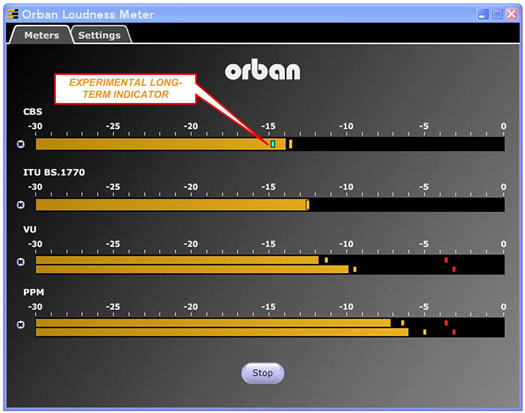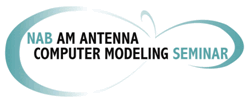|
Orban
Loudness Meter for Windows Computers
Every radio
station has a need for audio metering, and audio processing company
Orban (Tempe, AZ, www.orban.com)
recently made available the Orban Loudness Meter software as a
free downloadable program for computers running Windows XP and
Vista operating systems. Included in this software is an “experimental”
long-term loudness indication algorithm which attempts to mimic
a skilled operator’s mental integration of the peak swings
of a meter with “VU-like” dynamics.
 Sounds
to be monitored by this software are fed into the computer through
the line-in or microphone inputs on the computer soundcard (the
software accepts two-channel stereo inputs). Simultaneously displayed
on the computer screen are instantaneous peaks, VU, Peak Program
Meter (PPM), CBS Technology Center loudness, and ITU BS.1770 loudness
(see screen shot at right). All meters include peak-hold functionality
that makes the peak indications of the meters easy to see. The
VU and PPM meters are split to indicate the left and right channels.
The PPM meter also displays the instantaneous peak values of the
L and R digital samples. Adjustable settings include VU meter
gain (-10 to +10 dB), PPM attach time (5 or 10 msec), and meter
refresh rate (20 Hz to 100 Hz). Additional information provided
below on the various algorithms has been obtained from the Orban
Loudness Meter installation notes, www.orban.com/meter/Installation.html. Sounds
to be monitored by this software are fed into the computer through
the line-in or microphone inputs on the computer soundcard (the
software accepts two-channel stereo inputs). Simultaneously displayed
on the computer screen are instantaneous peaks, VU, Peak Program
Meter (PPM), CBS Technology Center loudness, and ITU BS.1770 loudness
(see screen shot at right). All meters include peak-hold functionality
that makes the peak indications of the meters easy to see. The
VU and PPM meters are split to indicate the left and right channels.
The PPM meter also displays the instantaneous peak values of the
L and R digital samples. Adjustable settings include VU meter
gain (-10 to +10 dB), PPM attach time (5 or 10 msec), and meter
refresh rate (20 Hz to 100 Hz). Additional information provided
below on the various algorithms has been obtained from the Orban
Loudness Meter installation notes, www.orban.com/meter/Installation.html.
The CBS meter
is a "short-term" loudness meter intended to display
the details of moment-to-moment loudness with dynamics similar
to a VU meter. It uses the Jones & Torick algorithm developed
at the CBS Technology Center and published in 1981 in the SMPTE
Journal. Created using Orban-developed modeling software, the
DSP implementation typically matches the original analog meter
within 0.5 dB on sine waves, tone bursts and noise. Orban developed
the CBS meter software because it was deemed useful for practicing
sound engineers and researchers and because it is used in an Orban
product, the Optimod 8585 Surround Audio Processor. The “experimental”
indicator mentioned above is visible as a single cyan bar on the
CBS loudness meter and uses a relatively simple algorithm; Orban
is soliciting feedback on its perceived usefulness.
The Jones
& Torick algorithm has its foundation in psychoacoustic studies
done at CBS Laboratories over a two year period by Emil Torick
and the late Benjamin Bauer. After surveying existing equal-loudness
contour curves and finding them inapplicable to measuring the
loudness of broadcasts, Torick and Bauer organized listening tests
that resulted in a new set of equal-loudness curves based on octave-wide
noise reproduced by calibrated loudspeakers in a semi-reverberant
16’ x 14’ x 8’ room, which is representative of
a room in which broadcasts are normally heard. In 1966, they published
this work in the IEEE Transactions on Audio and Electroacoustics,
along with results from other tests whose goal was to model the
loudness integration time constants of human hearing.
The ITU BS1770
loudness meter uses a frequency-weighted root-mean-square (RMS)
measurement intended to be integrated over several seconds—perhaps
as long as an entire program segment. As such, it is considered
a "long-term" loudness measurement because it does not
take into account the loudness integration time constants of human
hearing, as does the CBS meter. The ITU-R published Recommendation
ITU-R BS.1770,"Algorithms to measure audio programme loudness
and true-peak audio level" in 2006.
Orban's BS.1770
loudness meter implementation uses the Leq(RLB2) algorithm as
specified in the Recommendation. This applies frequency weighting
before the RMS integrator. The frequency weighting is a series
connection of pre-filter and RLB weighting curves. The Orban meter
precisely implements equations (1) and (2) in this document by
using a rolling integrator whose integration time is user-adjustable
from one to ten seconds.
The Orban
software runs on computers having 1.5 GHz or faster Intel or Intel-compatible
processors that implement the SSE2 instruction set. The software
can be driven by any installed Windows sound device. According
to Orban, this is the first of a family of Orban meters. Future,
paid versions are expected to offer upgraded features including
logging, surround monitoring, and oversampled peak measurements
that accurately indicate the peak level of the audio after D/A
conversion. The Orban Loudness Meter can be found on the Internet
at http://www.orban.com/meter.
 NAB
AM Antenna NAB
AM Antenna
Computer Modeling Seminar
November 20-21, 2008
NAB Headquarters
Washington, DC
Don’t miss this opportunity for broadcast engineers to learn
the basics needed to utilize modeling software such as MININEC
and nodal analysis for designing performance-optimized AM directional
antenna phasing and coupling systems and proving the performance
of directional antenna patterns.
You
will learn about:
-
Moment
Method Modeling Basics
-
DA
Proofing Using Moment Method Modeling
-
Overcoming
Limitations of Using Field Strength Measurements for DA Proofs
-
State
of the Art in Phasing System Design Nodal Analysis of AM DA
Phasing and Coupling Systems
-
Pattern
Design Considerations for Optimum Performance
AM
antenna experts Ron Rackley and Ben Dawson, along with antenna
modeling software specialist Jerry Westberg, will lead the seminar
demonstrating how moment method modeling makes analysis of actual
tower current distributions possible and how a model can be used
to proof an array provided the proper criteria are considered.
All instructors are well known in the radio industry as experts
in the field of directional antenna design and maintenance. Their
decades of experience offer station engineers an opportunity to
learn techniques, tips and tricks that can be immediately useful.
Seminar
fee: $395.00 (NAB members) and $495.00 (non-members). For
more information on the curriculum, how to register or housing
go to AM
DA Seminar on the NAB Web site or call Sharon Devine at (202)-429-5338.
Register now for the NAB AM Antenna Computer Modeling Seminar!


The
June 9, 2008 Radio TechCheck is also available
in an Adobe Acrobat file.
Please
click
here to read the Adobe Acrobat version of Radio TechCheck.
|

